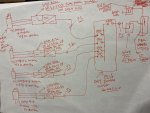hhsting
Senior Member
- Location
- Glen bunie, md, us
- Occupation
- Junior plan reviewer
Attached sketch shows (2) Solaredge SE43.2kUS three phase inverter for 208V grid and (2) Solaredge SE14.4kUS three phase inverter for 120/208V grid.
I have feeders from AC side of inverters labeled F1, F2, F3, F4 go to AC panelboard PV-1. There are No other loads PV-1 panel. From PV-1 panel feeder F5 goes to AC fused disco which then connects to grid and also to building loads.
NEC 2014 section 705.95(B) is confusing conductors used solely for instrumentation, voltage detection, or phase detection. Would conductors labeled F1, F2, F3, F4, F5 considered used solely for instrumentation, voltage detection, or phase detection and fall under NEC 2014 Section 705.95(B) or not?
I have feeders from AC side of inverters labeled F1, F2, F3, F4 go to AC panelboard PV-1. There are No other loads PV-1 panel. From PV-1 panel feeder F5 goes to AC fused disco which then connects to grid and also to building loads.
NEC 2014 section 705.95(B) is confusing conductors used solely for instrumentation, voltage detection, or phase detection. Would conductors labeled F1, F2, F3, F4, F5 considered used solely for instrumentation, voltage detection, or phase detection and fall under NEC 2014 Section 705.95(B) or not?


